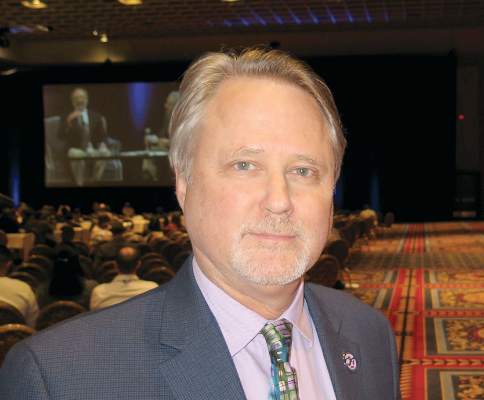REPORTING FROM NPA 2018
LAS VEGAS (FRONTLINE MEDICAL NEWS) – On April 16, 2007, a 23-year-old man shot 32 people to death and injured 23 others during a massacre on the campus of Virginia Tech University in Blacksburg, before taking his own life. On the same day, 231 other gun casualties occurred in other areas of the United States, 83 of them fatal and 148 nonfatal, according to Jeffrey W. Swanson, PhD.
“These were domestic violence incidents, suicides, some unintentional injuries, and a few law enforcement actions,” he said at an annual psychopharmacology update held by the Nevada Psychiatric Association. “This is the daily drip, drip, drip of gun violence in our country.”
According to data from the Substance Abuse and Mental Health Services Administration , 9.8 million adults in the United States have a serious mental illness, 2.5 million have a co-occurring substance use disorder, 1.9 million have no insurance, 3.1 million go without treatment for their mental illness, 100,000 are homeless, and about 1 million find themselves in jail or in prison. “We probably have more people with a serious mental illness in one of our big-city jails every day than we ever had in the largest asylum in the middle of the 20th century,” said Dr. Swanson , professor of psychiatry and behavioral sciences at Duke University, Durham, N.C. “I think that’s scandalous. It probably costs our society $318 billion per year. On the other hand, we have gun-related violence that claims 36,000 lives each year. One economist estimates that costs our society $174 billion per year. Those are two different public health problems that come together on their edges.”
Americans tend to think about mental illness and gun violence after all-too-frequent mass shootings at schools, workplaces, or concert events, he continued. “A mass shooting at a public place is so terrifying, and destructing and irrational,” he said. “It’s everything we don’t want our ordinary lives to be. We want our lives to be safe and to make sense. A mass shooting is none of those things. The act of going out and shooting a bunch of strangers is not the act of a healthy mind.
“But that person is very atypical in two ways: atypical of people with serious mental illnesses, most of whom are not violent and never will be, and atypical of the perpetrators of gun violence, the vast majority of whom do not have serious mental illnesses. But talking about both of these problems together in the aftermath of a mass shooting is too often the conversation that we’re stuck with.”
In 2015, there were 36,252 gun-related deaths in the United States. Of these, 61% were suicides, 36% were homicides, 2% were police-related, and 1% were unintentional. “We hear prominent voices in the public square today telling us that this is a problem related to mental health, and that the logical solution is to fix the mental health care system,” Dr. Swanson said. “As a mental health services researcher who has spent my career trying to build evidence for better policies to improve outcomes for people with serious mental illnesses, and knowing that the mental health care system we have is fragmented and overburdened – that the treatments we have don’t work very well for some people – I firmly believe we need to invest in and improve the mental health care system. But the idea that this alone is going to solve our problem of gun violence is misguided, in my opinion.”
Homicide data from the International Crime Victim Survey , conducted by Gallup Europe in 2000, found that in the United States, assaults are three more times likely to involve guns than in 14 other industrialized countries, including France, the United Kingdom, Canada, Spain, Belgium, and Australia. Moreover, there is an average of 97 guns for every 100 people in the United States, compared with an average of 17 guns per 100 people in all other industrialized countries. The violent crime rate in the United States is close to the average in 15 other industrialized countries in Western Europe, the United Kingdom, Canada, Australia, and Japan: 5.5%, compared with 6.3%.
At the same time, the United States has a homicide rate several times higher than the rate in these other countries. “How can you have this paradox where our crime rate is about average, but our homicide rate is not average?” Dr. Swanson asked. “It has something to do with our unique relationship with firearms.” The way he sees it, after the Supreme Court decision in District of Columbia v. Heller, confirming the individual right to bear arms under the Second Amendment, “gun control is really ‘people control.’ It focuses on dangerous people. We can’t broadly limit legal access to guns. We have to figure out, ‘Who are the people so dangerous that it is justified to limit their Second Amendment right?’ That’s very hard to do. Why? Because gun violence is very complicated. It’s caused by many factors that interact with each other, and they are nonspecific – meaning that they apply to many more people who are not going to do the thing you’re trying to prevent than who will.
“Serious mental illness may be one factor – particularly in terms of gun suicide – but it contributes very little (only about 4%) to overall interpersonal violence. People with serious mental illnesses are far more likely to be victims of violence than they are to be perpetrators.”
Factors linked to a propensity for violence include being young and male, poverty, exposure to violence, being abused as a child, and substance abuse. “If we could reduce substance abuse, our violence problems would go down by about 34%,” he said.
Recently, Dr. Swanson led a team of researchers that set out to analyze descriptive information on 762 individuals subjected to gun removal in Connecticut between 1999 and 2013, as part of that state’s “risk warrant” gun law ( Law Contemp Probl. 2017;[80]179-208 ). Enacted in 1999, the statute allows police, after independently investigating and determining probable cause, to obtain a court warrant and remove guns from anyone who is found to pose an imminent risk of harming someone else or himself or herself.
Dr. Swanson and his associates found that the individuals had an average of seven guns, 92% were male, and their mean age was 47 years. Most (81%) were married or cohabitating, 46% had a mental health or substance abuse record, 12% had an arrest leading to conviction in the year before or after, 61% were considered a risk of harm to self, 49% of calls to police about the individual came from family members or acquaintances, and 55% were transported to the emergency department or hospital. The researchers found that the proportion of people in treatment in the public behavioral health care system increased from 12% before the gun removal event to 29% after the gun removal event.
When they matched the death records, they found 21 suicides among these 762 patients, which was about 40 times greater than the suicide rate in the general adult population in Connecticut, 12 per 100,000. “That’s important, because if you think about suicide as a needle in a haystack, this law provides a way to identify a much smaller haystack with a lot more needles in it,” Dr. Swanson said. “So it’s more efficient to try to intervene to prevent gun suicide or violence in a group like that, and it shows that this policy is narrowly tailored.” When the researchers examined the method of suicide, they found that only 6 out of 21 individuals used a firearm, and none of the gun-involved suicides happened during the year when the firearms were retained. “They all happened when the person became eligible to get their guns back,” he said. “Using information on the fatality rate for each method of suicide, we estimated that for every 10-12 gun removals, one life was saved. Is that high or low? It depends on where you stand. If you’re someone who cares a lot about the right to own firearms, you might think that’s unacceptable. If you’re like me and you have had three gun suicides in your extended family, every one is a tragedy, a life cut short. We want to put this kind of calculation in the hands of lawmakers so they can see what is in the balance between risks and rights.”
Dr. Swanson ended his presentation by offering five principles aimed at guiding gun policy reforms related to mental illness:
Prevent the unpredictable through comprehensive background checks, but also by reducing the social determinant of violence and investing in improved access to mental health and substance abuse services.
“This is a complex puzzle, with maybe a couple of pieces hidden under the rug,” Dr. Swanson said.
He reported having no financial disclosures.




